
chapter spotlight
Laura E. Enriquez, UC Irvine assistant professor of Chicano/Latino studies, is leading a two-year, multicampus study on the impact of federal immigration policy on the University of California student population. Funded by a $270,000 UC Multicampus Research Programs & Initiatives grant, the project launched in January. Enriquez is working with colleagues at UC Berkeley, UC Irvine, UCLA, UC Merced and UC Riverside.
The research team will survey students who are undocumented as well as citizen students who have undocumented relatives to determine the effects of recent immigration policy shifts on their education and well-being. Additionally, the grant will fund development of a cohort of scholars conducting policy-relevant research, including conferences, reports and working papers highlighting key findings and best practices to promote immigrant and student equity.
Overview
The University of California’s distinguished faculty and academic employees serve as a rich source of innovation, discovery, and mentorship. They provide top-quality education to students, develop groundbreaking research, and serve California communities. No other public institution can claim so many distinguished academics: 65 Nobel Prizes, 63 National Medals of Science, 89 MacArthur Genius Awards, nine National Humanities Medals, and 42 Pulitzer Prizes, to name a few. President Napolitano has said, “We teach for California … [and] we research for the world.”
Describing the academic workforce
Academic FTE and Headcount, October 2018
|
FTE |
Headcount |
| Faculty - Ladder-rank and Equivalent |
10,322.9 |
11,277 |
| Faculty - Clinical/In-Residence/Adjunct |
7,199.5 |
8,122 |
| Faculty - Lecturers |
2,369.3 |
3,940 |
| Other Academic Employees |
6,143.5 |
8,381 |
| Postdoctoral Scholars |
5,373.0 |
6,502 |
| Medical Interns/Residents |
5,891.2 |
6,075 |
| Student Teaching/Research Assistants |
10,558.9 |
26,056 |
| Grand Total |
47,858.3 |
70,353 |
Faculty are the most prominent face of UC’s academic workforce, but there are several types of faculty and other academic roles as well, totaling nearly 48,000 full-time equivalents (FTE) across over 70,000 individuals. About 60 percent of academic roles are support the general campuses, while the other 40 percent support the health sciences and medical centers. Since 2000, all faculty groups have grown, with lecturers increasing by over 70 percent, while ladder-rank and equivalent faculty increased by 35 percent.
Non-faculty academic positions have grown as well, notably student assistants and medical interns. Postdoctoral scholars are sponsored by faculty and typically paid through research contracts and grants, so their numbers concentrate in the medical and STEM fields and vary with available grant funding.
Diversity
The University of California is committed to diversity in its faculty and academic workforce. The proportion of women and underrepresented groups (African American, American Indian, and Hispanic/Latino(a)) in the faculty continues to grow at a modest pace. Younger faculty cohorts are noticeably more diverse than older cohorts.
Compared to ladder-rank faculty, many other academic positions are more ethnically diverse and gender-balanced because they experience more rapid turnover. Still, UC compares favorably in terms of female faculty and underrepresented faculty relative to the comparison eight peer research institutions[1]. UCOP continues to work with campuses to identify opportunities to diversify the faculty and improve recruitment processes and campus climate by tracking recruitment data, by sharing best practices in mentoring and professional development, and by enhancing work-life balance programs.
A variety of programs have been put in place to strengthen faculty diversity:
Advancing Faculty Diversity — The State of California has awarded UC $2 million for the last three years to develop an innovative and focused program to increase faculty diversity at UC. The Advancing Faculty Diversity program awards funds on a competitive basis to the campuses to support new interventions in the faculty recruitment process to improve faculty diversity, that can be measured for their effectiveness. Eleven pilot projects on faculty recruitment have been funded by the state, including projects located in colleges, schools, and departments. In addition, in 2018–19, six awards have been funded by the Office of the President to support efforts in faculty retention and in building inclusive academic climates. Some of the successful interventions from the first two years of the pilot program that correlate with hiring a diverse faculty included the use of contributions to diversity statements early in the evaluation process; targeting potential faculty earlier in their careers through support for postdoctoral work; a variety of efforts by faculty to actively recruit candidates; revised evaluation practices, including the use of rubrics to guide decision-making; strong leadership and sustained and strategic involvement from unit leaders; and involving new voices, including students, in the recruitment and evaluation process.Encouraged by the success of this program, the President is providing additional funding of $7.1 million that will build the pipeline to the faculty. These funds will support additional projects in faculty recruitment, retention, and academic climate that will pilot innovative recruitment practices and create academic climates that support our diverse student body and allow us to engage our diverse faculty throughout their UC careers.
President’s Postdoctoral Fellowship Program (PPFP) — Established in 1984, the program recruits top scholars who are committed to underserved and minority communities to pursue faculty careers at UC. Between 2016–17 and 2018–19, 60 fellows were hired as UC ladder-rank faculty at all ten UC campuses. In addition, more than 20 fellows have reported being successfully recruited for UC faculty positions that will begin in 2019–20. Through Presidential support, UC has increased the number of incentives available to departments who hire fellows and expanded eligibility for hiring incentives to include the health sciences and professional schools. The program is nationally recognized and leads a partnership of top universities that participate in recruiting top postdoc talent.
Grant-funded research — Since 2015, UC has administered two National Science Foundation grants to study the faculty hiring process. The study is identifying steps in UC’s hiring process susceptible to bias, characteristics that amplify or mitigate disparities, as well as policies to promote faculty equity, inclusion, and diversity. UC was also awarded a five-year grant to establish the Center for Research, Excellence, and Diversity in Team Science (CREDITS), a research and training program to enhance the capacity, effectiveness, and excellence of team science efforts at UC and CSU. CREDITS researches gender and racial/ethnic diversity in team science, particularly barriers to diverse participation and how diversity shapes the formation of science teams and the implications for promotion and tenure.
Hiring and retention
Overall hiring of UC faculty generally outpaces availabilities of U.S. doctoral degree recipients by race, ethnicity, and gender, with some notable differences by field. STEM fields have more limited ability to diversify, based on Ph.D. availabilities.
Faculty hires have stabilized after several years of increases as UC recovered from severe budget cuts, and as enrollment growth demanded greater teaching capacity. Faculty separations have grown modestly — especially due to increasing retirements. Average faculty salaries at UC have improved somewhat in recent years; however, they still trail those at many comparison institutions, particularly a benchmark of the average of salaries at the “Comparison 8,” a group of four public and four private institutions. UC continues to pursue efforts to close the gap.
As part of the multi-year framework adopted by the UC Regents in early 2019, known as UC 2030—Advancing the California Dream, UC is hoping to receive additional state support to hire 1,100 ladder-rank faculty over the next four years (5.3.5). With growth, UC is hoping to continue to increase the diversity of its ladder-rank faculty, but that also involves retaining faculty who contribute to that diversity. Data from UC system records of new hires and separations of tenure-track and tenured faculty show that although faculty for historically underrepresented minority communities made up 14.3 percent of all tenure-track (Assistant Professor and Lecturer with Potential Security of Employment) new hires between 2008–09 and 2017–18, they comprised 15.7 percent of tenure-track resignations. The racial/ethnic retention gap was more pronounced among domestic faculty, where faculty from historically underrespresented minority communities comprised 15.8 percent of new hires, but 20 percent of separations, and 19.5 percent of resignations among tenure-track faculty.
For more information
UC faculty have increased to accommodate a growing student body, relying more on non-senate faculty today than in years past.
5.1.1 General campus faculty FTE total by type, Universitywide, October 2000 to 2018

Source: UC Corporate Personnel System
Since 2000, faculty size has increased by nearly 3,300 FTE, or 40.6 percent. While all faculty types have grown, the most pronounced increase has been among lecturers, who grew over 70 percent during this period. Lecturers made up more than 20 percent of general campus faculty FTE in October 2018, a slight increase from 17 percent in 2000.
Ladder-rank faculty have grown by a more modest 35 percent, but they still make up 76 percent of faculty FTE. FTE in the Clinical/In-Residence/Adjunct faculty series are typically associated with health sciences, so they represent only a small portion (four percent) of overall general campus faculty.
Reliance on lecturers has become more common in higher education in recent years. At UC, lecturers do not have research responsibilities and therefore focus on teaching. These faculty help meet the instructional needs of UC’s growing enrollment.
General campus faculty are mostly concentrated in arts and humanities and the social sciences.
5.1.2 General campus faculty headcount by discipline, Universitywide, October 2018

Source: UC Corporate Personnel System
Faculty are employed in hundreds of departments across the ten campuses. While most health sciences faculty are classified under medicine and other health sciences, general campus faculty are spread across a spectrum of disciplines. The disciplines with the most undergraduate majors tend to represent the largest groups. Arts & Humanities may have especially high numbers, due the smaller class sizes required to teach many general education courses.
Different disciplines rely on varying types of faculty to fulfill their teaching and research missions. Lecturers are concentrated in certain disciplines, such as the arts and humanities, often to support general education requirements in those areas. Lecturer positions are also common in the professional schools.
The non-faculty academic workforce has increased steadily, particularly among student assistants and medical interns. Other academic and postdoctoral growth aligns closely with faculty growth and the availability of research funding.
5.1.3 Non-faculty academic workforce FTE, Universitywide, October 2000 to 2018
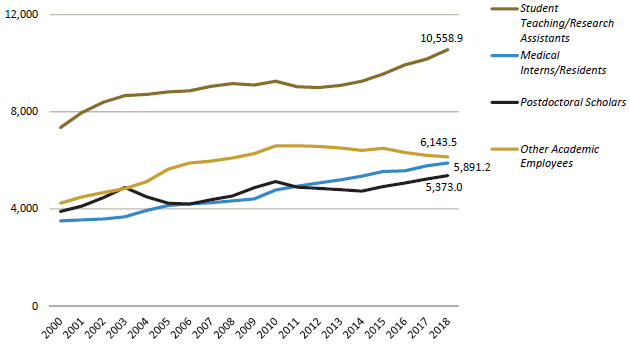
Source: UC Corporate Personnel System
The non-faculty academic workforce has expanded alongside student and faculty growth since 2000, increasing by nearly 9,000 FTE, or 47 percent, over this period.
Student teaching and research assistants as well as medical interns/residents have increased in number considerably, constituting almost 5,600 of the FTE growth. Most student assistants are graduate students and therefore part-time, which means that the FTE growth equates to a larger headcount growth of close to 8,300 individuals. Enrollment increases and expansion of medical programs over this time explain this growth.
Postdoctoral scholars and other academics, two groups heavily concentrated within the research mission, have also grown in line with faculty. Contracts and grants from external sponsors support the vast majority of researchers in the academic workforce, with the federal government providing most research funding. A drop in federal research funds after 2010 flattened other academic growth and reduced postdoctoral FTE in the years following. Chapter 9, Research, provides additional details on the composition of the research workforce.
Postdoctoral scholars are concentrated in medicine, science, and engineering, as well as at campuses with larger research programs in those fields.
5.1.4 Postdoctoral scholar headcount, By campus and discipline, October 2018
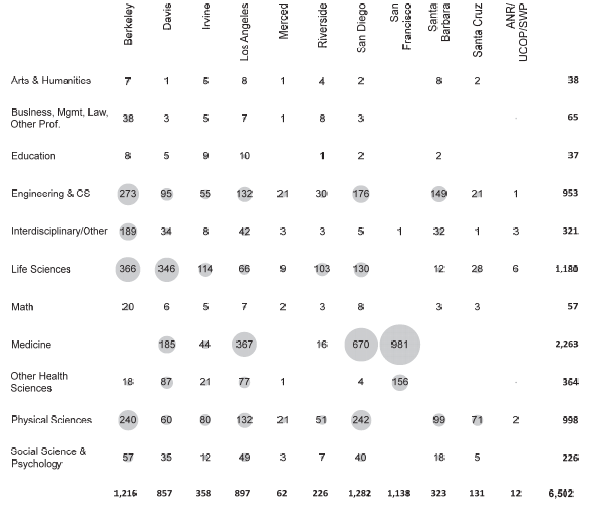
Source: UC Corporate Personnel System. Only includes postdocs paid through the University, not those paid directly by extramural funds.
Note: ANR/UCOP/SWP is Agricultural and Natural Resources/UC Office of the President/Systemwide Programs
Postdoctoral scholars have doctorate degrees and conduct research with faculty. Because most of their funding comes from contracts and grants, they are particularly prevalent in fields that receive large amounts of grant funding such as medicine, life sciences, physical sciences, and engineering. Campuses with large research programs in these fields consequently have larger postdoctoral populations.
Beyond direct research, postdoctoral scholars mentor graduate and undergraduate students in the laboratory and may have formal supervisory functions.
The diversity of UC’s academic workforce differs among the types of employees.
5.2.1 Academic workforce race/ethnicity by type, Universitywide, October 2000 to 2018
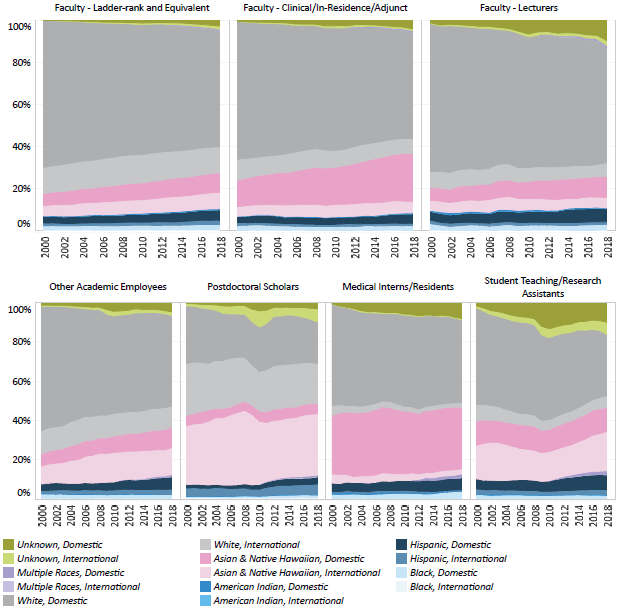
Source: UC Corporate Personnel System
All academic positions have increased in racial/ethnic diversity since 2000. Positions with shorter durations (e.g. Students, Interns/Residents) tend to be more diverse, since turnover allows for increased diversity in hiring. Ladder-rank faculty diversity has been the slowest to change, due to long tenures and limited availability of candidates in some disciplines. Overall, a great number of academics are international, reflecting a global academic marketplace. Campus, discipline, and age detail is available through the UC Information Center.
Gender diversity has increased or maintained parity for every academic group but still falls short of parity in several academic appointee categories.
5.2.2 Academic workforce gender by type, Universitywide, October 2000 to 2018
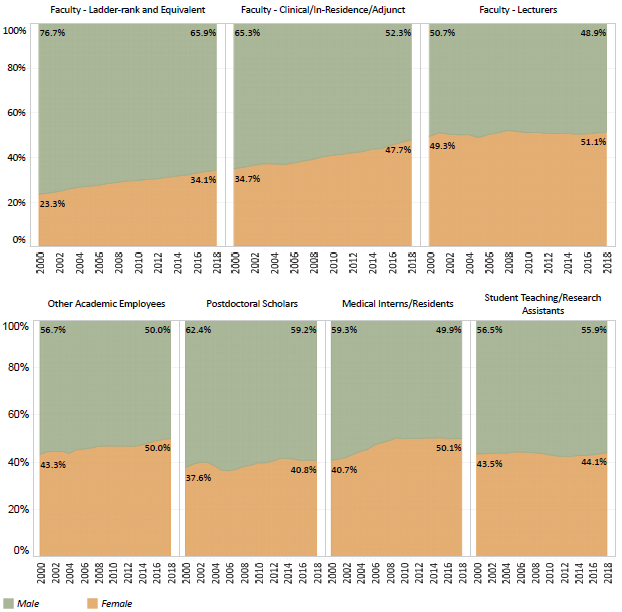
Source: UC Corporate Personnel System
Today, women make up half of lecturers, other academics, and medical interns/residents. The ratio of women among Clinical/In-residence/Adjunct faculty and ladder-rank faculty has risen steadily. Gender diversity initiatives take longer to change populations such as ladder-rank professors, where turnover is low and tenures are long. Postdoctoral scholars and student assistant ratios have remained relatively flat, likely related to the concentrations of those roles in fields with more men in the pipeline.
UC has greater faculty diversity in terms of women and underrepresented minorities than many peers.
5.2.3 Percent of tenure and tenure-track faculty who are female and/or an underrepresented group (URG), UC and comparison institutions, Fall 2017
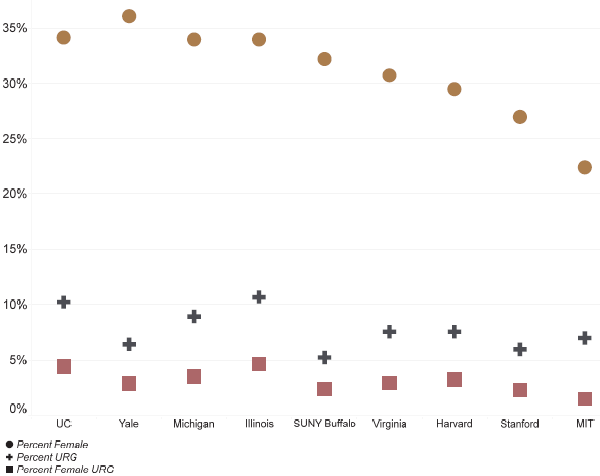
Source: IPEDS, Fall 2017
UC’s efforts to recruit women and underrepresented groups (American Indian, African American, and Hispanic/Latino(a)) into faculty roles puts it near the top among peer research institutions in faculty diversity.
Relative to the “Comparison 8” universities (four public institutions: Illinois, Michigan, University at Buffalo, Virginia; four private institutions: Harvard, MIT, Stanford, Yale), UC is the second highest in terms of its proportion of women faculty (34.1 percent), its proportion of overall URG faculty (10.2 percent), and its proportion of female URG faculty (4.4 percent).
UC’s hiring of underrepresented and female faculty overall exceeds or meets the national availability of doctorates, with variation among discipline groups.
5.3.1 Underrepresented* new assistant professors compared with national availability by discipline group, Universitywide, 2013–14 to 2017-18
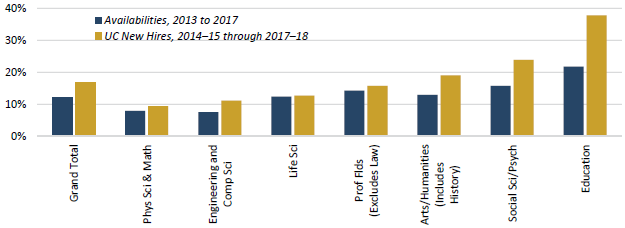
* Underrepresented at UC includes those who identify as Black/African American/African, Chicano/Latino/Hispanic, and American Indian/Native American.
5.3.2 Female new assistant professors compared with national availability by discipline group, Universitywide, 2013–14 to 2017-18
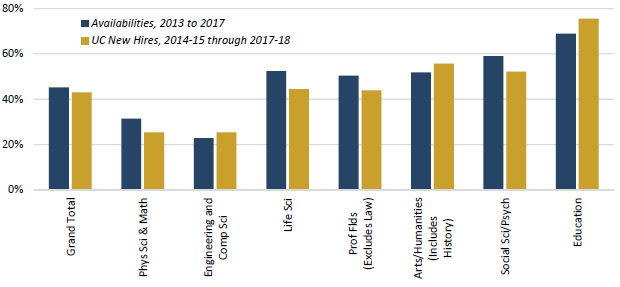
Source: UC Academic Personnel and Program Administration and Survey of Earned Doctorates
UC remains committed to diversifying its faculty and taking full advantage of the available pools of qualified candidates. Between 2013 and 2017, underrepresented groups accounted for 12.3 percent of nationwide new doctoral degree recipients and 16.8 percent of UC’s new assistant professor hires. Between 2013 and 2017, women constituted 45.2 percent of nationwide new doctoral degree recipients and 43 percent of UC’s new hires. Some disciplines exhibit greater success in outreach, recruitment, and hiring efforts at UC than others, relative to the availability pools in their field.
Hiring of new faculty has ebbed and flowed over the years in response to budget cuts and enrollment growth. Separations have been more consistent, year over year.
5.3.3 New hires and separations of ladder-rank and equivalent faculty, Universitywide, 2000-01 to 2017-18

Source: UC Academic Personnel and Program Administration
As faculty numbers have grown, hiring has generally outpaced separations. Separations have grown modestly over time as the faculty population has grown, with only minor effects from shifts in demographics, the economy, and state funding.
UC has partnered with Harvard's Collaborative on Academic Careers in Higher Education (coache.gse.harvard.edu/) on a research project to survey faculty who leave UC for employment at other universities. This Retention and Exit Study, now in its fifth year, is part of an effort to better understand and improve the experience of UC faculty members, as well as improve recruitment and retention.
UC faculty salaries are below the comparison institution benchmark.
5.3.4 Average ladder-rank general campus faculty salaries by rank, UC and comparison institutions, 2000–01 to 2018-19
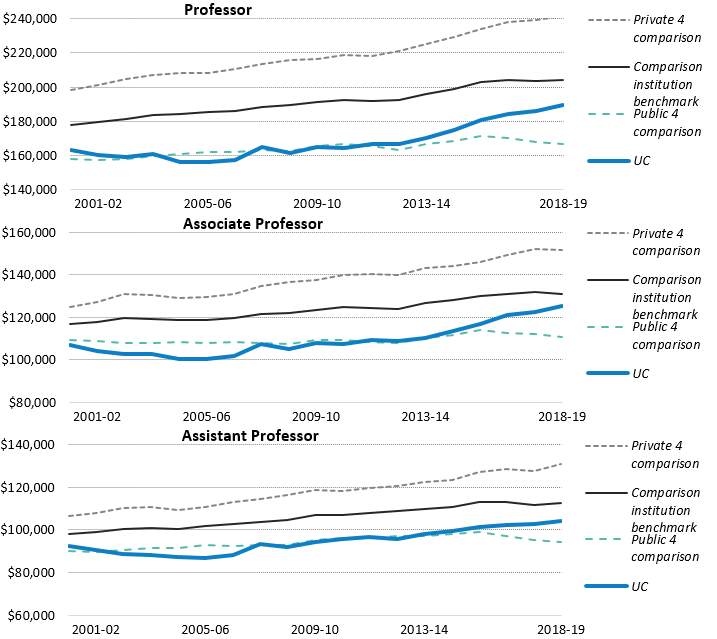
Source: UC Corporate Personnel System, AAUP faculty salary survey
UC faculty salaries have improved in recent years, yet they continue to lag behind the comparison benchmark UC uses to assess the competitiveness of its faculty salaries. UC sets the benchmark using the average salaries of the “Comparison 8” universities (four public: Illinois, Michigan, University at Buffalo, Virginia; four private: Harvard, MIT, Stanford, Yale).
UC’s faculty salaries fall significantly below those of the comparison private institutions, and are just recently pulling above the four public institutions. Notably, this comparison does not factor in the cost of living, which is especially high in most of California compared to the regions of the public peers assessed here.
5.3 ACADEMIC HIRING AND RETENTION
Growth in UC ladder-rank faculty is critical to upholding quality in instruction, research, and public service.
5.3.5 UC ladder-rank faculty headcount, excluding recall faculty*, Universitywide, October 2000 to 2018

*Recall faculty are retired faculty brought back part-time for temporary instruction and/or research needs. They are excluded here to focus on more permanent faculty appointments only.
Growth among UC ladder-rank and equivalent (LRE) faculty has been modest over the last couple of decades, relative to the growth in the student body. One of UC’s goals in the multiyear framework adopted by the UC Regents in 2019 is investing in the next generation of the professoriate.
To fulfill this, UC seeks to grow non-recall LRE faculty by 1,100 over the next four years.
After four years, UC leadership will assess progress toward advancing undergraduate and graduate degree attainment and diversifying the professoriate.












